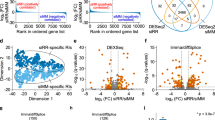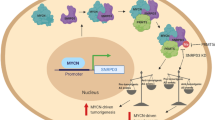Abstract
The hematopoietic transcription factor Spi-1/PU.1 is an oncoprotein participating to the malignant transformation of proerythroblasts in the Friend erythroleukemia or in the erythroleukemic process developed in spi-1 transgenic mice. Overexpression of Spi-1 in proerythroblasts blocks their differentiation. We have shown that Spi-1 promotes the use of the proximal 5′-splice site during the E1A pre-mRNA splicing and interferes with the effect of TLS (Translocated in LipoSarcoma) in this splicing assay. TLS was identified from chromosomal translocations in human liposarcoma and acute myeloid leukemia. Here, we determine the function of Spi-1 domains in splicing and in the interference with TLS. In transient transfection assays in erythroid cells, we show that the DNA binding domain cooperates with the transactivation domain or the PEST region of Spi-1 to modify the function of TLS in splicing. Interestingly, the 27 C-terminal amino acids, which determine the DNA binding activity of Spi-1, are necessary for the splicing function of Spi-1 as well as for its ability to interfere with TLS. Finally, we demonstrate that in leukemic proerythroblasts overexpressing Spi-1, TLS has lost its splicing effect. Thus, we hypothesize that oncogenic pathways in proerythroblasts may involve the ability of Spi-1 to alter splicing.
This is a preview of subscription content, access via your institution
Access options
Subscribe to this journal
Receive 50 print issues and online access
$259.00 per year
only $5.18 per issue
Buy this article
- Purchase on Springer Link
- Instant access to full article PDF
Prices may be subject to local taxes which are calculated during checkout






Similar content being viewed by others
References
Auboeuf D, Honig A, Berget SM and O'Malley BW . (2002). Science, 298, 416–419.
Baechtold H, Kuroda M, Sok J, Ron D, Lopez BS and Akhmedov AT . (1999). J. Biol. Chem., 274, 34337–34342.
Behre G, Whitmarsh AJ, Coghlan MP, Hoang T, Carpenter CL, Zhang DE, Davis RJ and Tenen DG . (1999). J. Biol. Chem., 274, 4939–4946.
Bertolotti A, Lutz Y, Heard DJ, Chambon P and Tora L . (1996). EMBO J., 15, 5022–5031.
Bertolotti A, Melot T, Acker J, Vigneron M, Delattre O and Tora L . (1998). Mol. Cell Biol., 18, 1489–1497.
Bertrand P, Akhmedov AT, Delacote F, Durrbach A and Lopez BS . (1999). Oncogene, 18, 4515–4521.
Brass AL, Zhu AQ and Singh H . (1999). EMBO J., 18, 977–991.
Caceres JF, Stamm S, Helfman DM and Krainer AD . (1994). Science, 265, 1706–1709.
Calvio C, Neubauer G, MannM and Lamond AI . (1995). Rna, 1, 724–733.
Crozat A, Aman P, Mandahl N and Ron D . (1993). Nature (London), 363, 640–644.
Delattre O, Zucman J, Plougastel B, Desmaze C, Melot T, Peter M, Kovar H, Joubert I, De Jong P, Rouleau G, Aurias A and Thomas G . (1992). Nature (London), 359, 162–165.
Delgado MD, Hallier M, Meneceur P, Tavitian A and Moreau-Gachelin F . (1994). Oncogene, 9, 1723–1727.
Du L and Warren SL . (1997). J. Cell. Biol., 136, 5–18.
Fu XD . (1995). Rna, 1, 663–680.
Ge H, Si Y and Volffe AP . (1998). Mol. Cell, 2, 751–759.
Hagemeier C, Bannister AJ, Cook A and Kouzarides T . (1993). Proc. Natl. Acad. Sci. USA, 90, 1580–1584.
Hallier M, Lerga A, Barnache S, Tavitian A and Moreau-Gachelin F . (1998). J. Biol. Chem., 273, 4838–4842.
Hallier M, Tavitian A and Moreau-Gachelin F . (1996). J. Biol. Chem., 271, 11177–11181.
Ichikawa H, Shimizu K, Hayashi Y and Ohki M . (1994). Cancer Res., 54, 2865–2868.
Klemsz MJ, McKercher SR, Celada A, Van Beveren C and Maki RA . (1990). Cell, 61, 113–124.
Knoop LL and Baker SJ . (2000). J. Biol. Chem., 275, 24865–24871.
Knoop LL and Baker SJ . (2001). J. Biol. Chem., 276, 22317–22322.
Kuroda M, Sok J, Webb L, Baechtold H, Urano F, Yin Y, Chung P, de Rooij DG, Akhmedov A, Ashley T and Ron D . (2000). EMBO J., 19, 453–462.
Lerga A, Hallier M, Delva L, Orvain C, Gallais I, Marie J and Moreau-Gachelin F . (2001). J. Biol. Chem., 276, 6807–6816.
Maniatis T and Reed R . (2002). Nature, 416, 499–506.
Manley JL and Tacke R . (1996). Genes Dev., 10, 1569–1579.
Mayeda A and Krainer AR . (1992). Cell, 68, 365–375.
McKercher SR, Torbett BE, Anderson KL, Henkel GW, Vestal DJ, Baribault H, Klemsz M, Feeney AJ, Wu GE, Paige CJ and Maki RA . (1996). EMBO J., 15, 5647–5658.
Moreau-Gachelin F, Ray D, Mattei MG, Tambourin P and Tavitian A . (1989). Oncogene, 4, 1449–1456.
Moreau-Gachelin F, Tavitian A and Tambourin P . (1988). Nature (London), 331, 277–280.
Moreau-Gachelin F, Wendling F, Molina T, Denis N, Titeux M, Grimber G, Briand P, Vainchenker W and Tavitian A . (1996). Mol. Cell. Biol., 16, 2453–2463.
Nerlov C, Querfurth E, Kulessa H and Graf T . (2000). Blood, 95, 2543–2551.
Ohno T, Ouchida M, Lee L, Gatalica Z, Rao VN and Reddy ESP . (1994). Oncogene, 9, 3087–3097.
Pahl HL, Scheibe RJ, Zhang DE, Chen HM, Galson D, Maki RA and Tenen DG . (1993). J. Biol. Chem., 268, 5014–5020.
Perkel JM and Atchison ML . (1998). J. Immunol., 160, 241–252.
Petrovick HS, Hiebert SW, Friedman AD, Hetherington CJ, Tenen DG and Zhang DE . (1998). Mol. Cell. Biol., 18, 3915–3925.
Pongubala JMR, Vanbeveren C, Nagulapalli S, Klemsz MJ, Mckercher SR, Maki RA and Atchison ML . (1993). Science, 259, 1622–1625.
Powers CA, Mathur M, Raaka BM, Ron D and Samuels HH . (1998). Mol. Endocrinol., 12, 4–18.
Prasad DDK, Ouchida M, Lee L, Rao VN and Reddy ESP . (1994). Oncogene, 9, 3717–3729.
Rabbitts TH, Forster A, Larson R and Nathan P . (1993). Nat. Genet., 4, 175–180.
Ray-Gallet D, Mao C, Tavitian A and Moreau-Gachelin F . (1995). Oncogene, 11, 303–313.
Rekhtman N, Radparvar F, Evans T and Skoultchi AI . (1999). Genes Dev., 13, 1398–1411.
Scott EW, Fisher RC, Olson MC, Kehrli EW, Simon MC and Singh H . (1997). Immunity, 6, 437–447.
Screaton GR, Caceres JF, Mayeda A, Bell MV, Plebanski M, Jackson DG, Bell JI and Krainer AR . (1995). EMBO J., 14, 4336–4349.
Shimizu K, Ichikawa H, Tojo A, Kaneko Y, Maseki N, Hayashi Y, Ohira M, Asano S and Ohki M . (1993). Proc. Natl. Acad. Sci. USA, 90, 10280–10284.
Stolow DT and Haynes RH . (1995). Nucleic Acid Res., 23, 835–843.
Uranishi H, Tetsuka T, Yamashita M, Asamitsu K, Shimizu M, Itoh M and Okamoto T . (2001). J. Biol. Chem., 276, 13395–13401.
Wu SP and Green MR . (1997). EMBO J., 16, 4421–4432.
Yamamoto H, Kihara-Negishi F, Yamada T, Hashimoto Y and Oikawa T . (1999). Oncogene, 18, 1495–1501.
Yang L, Embree LJ and Hickstein DD . (2000). Mol. Cell. Biol., 20, 3345–3354.
Yang L, Embree LJ, Tsai S and Hickstein DD . (1998). J. Biol. Chem., 273, 27761–27764.
Yuryev A, Patturajan M, Litingtung Y, Joshi RV, Gentile C, Gebara M and Corden JL . (1996). Pro. Natl. Acad. Sci. USA, 93, 6975–6980.
Zhang P, Behre G, Pan J, Iwama A, Wara-Aswapati N, Radomska HS, Auron PE, Tenen DG and Sun Z . (1999). Proc. Natl. Acad. Sci. USA, 96, 8705–8710.
Zhang P, Zhang X, Iwama A, Yu C, Smith KA, Mueller BU, Narravula S, Torbett BE, Orkin SH and Tenen DG . (2000). Blood, 96, 2641–2648.
Zinszner H, Albalat R and Ron D . (1994). Genes Dev., 8, 2513–2526.
Acknowledgements
We thank Jean de Gunzburg, Jacques Camonis, Olivier Kosmider and Erwan Le Scolan for their advice and comments regarding the manuscript. We are grateful to N Brandon for technical assistance. LD was supported by fellowships from the Société Française d’Hématologie and from the Association pour la Recherche contre le Cancer. This work was supported by funds from the Institut National de la Santé et de la Recherche Médicale (Inserm), the Ligue Nationale contre le Cancer, the Association pour la Recherche contre le Cancer and the Fondation pour la Recherche Médicale.
Author information
Authors and Affiliations
Corresponding author
Rights and permissions
About this article
Cite this article
Delva, L., Gallais, I., Guillouf, C. et al. Multiple functional domains of the oncoproteins Spi-1/PU.1 and TLS are involved in their opposite splicing effects in erythroleukemic cells. Oncogene 23, 4389–4399 (2004). https://doi.org/10.1038/sj.onc.1207578
Received:
Revised:
Published:
Issue Date:
DOI: https://doi.org/10.1038/sj.onc.1207578
Keywords
This article is cited by
-
FUS interacts with nuclear matrix-associated protein SAFB1 as well as Matrin3 to regulate splicing and ligand-mediated transcription
Scientific Reports (2016)
-
The oncofusion protein FUS–ERG targets key hematopoietic regulators and modulates the all-trans retinoic acid signaling pathway in t(16;21) acute myeloid leukemia
Oncogene (2016)
-
Subtle distinct regulations of late erythroid molecular events by PI3K/AKT-mediated activation of Spi-1/PU.1 oncogene autoregulation loop
Oncogene (2010)
-
RNA processing pathways in amyotrophic lateral sclerosis
neurogenetics (2010)
-
EWS-FLI1 target genes recovered from Ewing's sarcoma chromatin
Oncogene (2005)



